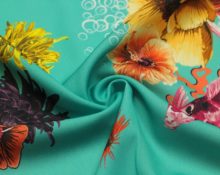It is a mistake to say that crepe is a specific fabric: this word refers to a large group of textiles with a rough surface. All kinds of clothing are sewn from this material, and it is used as home textiles. What crepe fabric is best for sewing a suit?
Description of costume crepe
Among the wide variety of crepe, there is a special type - costume, or costume. This soft, but at the same time dense material, lightweight, but at the same time holds its shape perfectly. The surface is slightly embossed, wavy or finely patterned, but pleasant to the touch. The light matte finish of the textile allows it to be used for sewing both festive and everyday clothes.
Suit crepe is available in a single color, in various colors, with a pattern or print.

Fabric composition and features
Crepe suiting fabrics are made from all types of fibers: natural threads (silk, cotton, wool), artificial threads based on cellulose (acetate, triacetate, viscose), synthetic (acrylic, polyester, polyamide, lavsan). To impart the necessary properties, it is possible to mix fibers, for example: adding polyester to viscose increases wear resistance. One of the features of the fabric is low elasticity. Even crepe jersey and stretch are difficult to stretch.
Depending on the type of fibers used 2 ways to make fabric. One of them is twisting. The threads used are tightly twisted in different directions (up to 3 thousand twists per 1 m²), and then crossed. This technology makes the fabric dense and elastic, not stretchable.
Reference. The density of a crepe suit is in the range of 210–240 g/m². For comparison: the density of calico is 120 g/m², wool – 150–300 g/m².
At the final stage of the technological process, the canvas is exposed to moisture and high temperature. The twisted threads are partially straightened, thereby forming a grainy structure of the fabric, which gives the fabric roughness. At the first touch it is alarming, but during wearing it does not cause discomfort.
By the way! If the threads are twisted along the warp and weft, the result is a purely crepe material with a more embossed and rough surface. If the threads are twisted only along the weft or warp, a fabric (semi-crepe) is formed that is less elastic and has a smoother surface.
The second method of making fabric is finely patterned weave without twisting, using additional threads that differ from the main ones. This difference in the source material and the random arrangement of the weaves create bulges (crepe effect). Such fabrics have higher elasticity.

Advantages and disadvantages
Suit crepe has more pros than cons, so let's look at the latter first. The disadvantages include the following:
- afraid of sunlight and high temperatures;
- requires delicate handling (typical of all crepe fabrics);
- subject to severe shrinkage (from natural fibers);
- high price.
The material is in demand due to the following physical, mechanical and hygienic properties:
- Low creasing.
- Comfort. The product made from the suit is pleasant to the touch and does not restrict movement.
- High tensile strength.
- Rigidity. During operation there is no sagging, stretching, folds and arrows “do not diverge”.
- Flexibility. The fabric drapes well, which makes it possible to make folds and use any cut.
- Good breathability.
- Hypoallergenic.
- Low hygroscopicity and dust holding capacity.
- But the main advantage is increased wear resistance. An item made from this material will last 10, 20 years or more, maintaining its appearance.

Are there varieties?
Depending on the fibers used, the textile industry offers many varieties of suit crepe:
- Crepe satin. Silk and synthetic threads and satin weave are used for production. Two sides, smooth shiny and rough matte, allow you to create interesting combinations when sewing.
- Crepe stretch. Viscose threads with elastane make the fabric more dense, maintaining softness and giving elasticity.
- Wool crepe Thin but dense, with a relief texture and matte shine.
- Crepe jersey made from artificial fibers. Has improved elasticity and flexibility.
- Crepe diving. Similar to knitted crepe, but has a silky surface. Due to its high elasticity it is called “second skin”. Used for sewing any clothes, including sportswear.
- Crepe diagonal. It has a diagonal scar on the surface. Jackets, jackets, and coats are made from it.
Other varieties include crepe-marroquin, barbie, crepon.
What do they make from a suit?
Despite the name “costume”, this type of crepe is used not only for sewing trousers, jackets, sundresses, and dresses. It is used to make any clothes (mostly women's), covers, children's toys, curtains, bedspreads, tablecloths, and is used for upholstery.
A separate topic is bedding - sheets, pillowcases, duvet covers. This is luxury bedding. It is environmentally friendly, durable, does not wrinkle, does not require ironing, has a beautiful texture, and is suitable for people with problem skin. The same applies to blankets and blankets.

How to care for it?
In order for a product made of suit crepe to delight you with its impeccable appearance for a long time, you must adhere to the following rules for caring for the fabric:
- Machine wash without soaking on delicate cycle. This is required by the fibers that make up the crepe.
- Do not heat the water above 30 °C. When washing by hand, your hand should feel slightly cool..
- It is advisable to use liquid detergents without enzymes. They dissolve faster in water and are more easily washed out from the spaces between the fibers, plus they do not leave white spots after drying. They are highly effective at low temperatures.
- Dry the product in the shade and away from heating devices, on hangers.
- The product should be ironed from the inside out, in a slightly damp state, with the iron heated to no higher than 140 °C.
- You can store clothes on hangers or folded on shelves, in paper or linen bags.
Important! It is better to dry clean items made from suit crepe with a complex cut.
Ignoring these recommendations leads to damage to the fibers, as a result of which the fabric loses its properties and the product loses its original appearance.


 0
0





